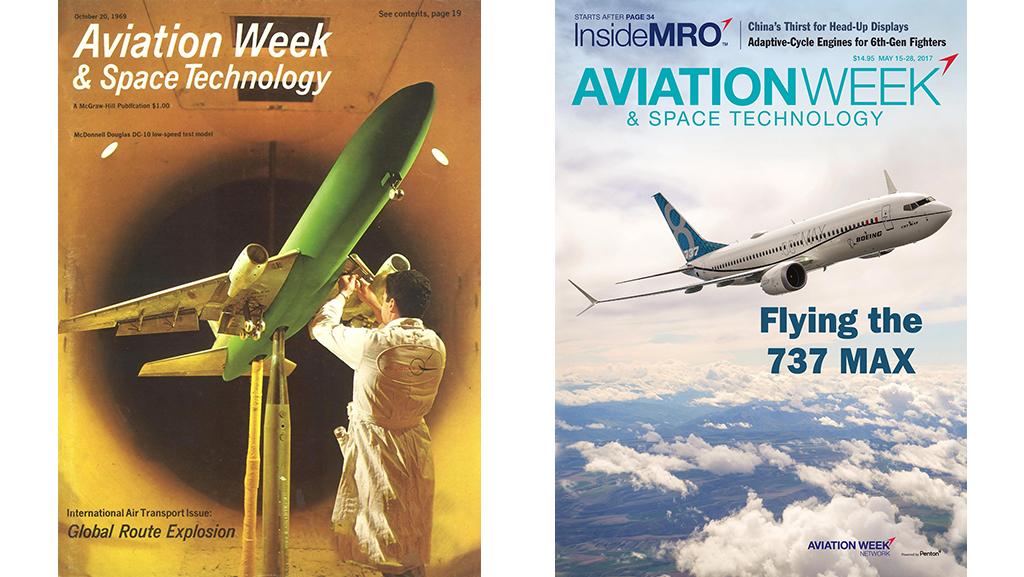
Douglas Aircraft started down a 30-year path toward extinction when it merged with McDonnell in 1967. McDonnell management prioritized military programs and was not willing to make the investment necessary to maintain its commercial jetliner market position. By the time it merged with Boeing, Douglas’ jetliner products were on their last legs.
It has been nearly 25 years since Boeing and McDonnell Douglas merged. Given Boeing’s significant engineering cuts, program execution problems, clear prioritization of shareholder returns, extremely uncertain product development road map and deteriorating market share outlook, it is time to consider whether Boeing Commercial Aircraft (BCA) is destined to share Douglas’ fate. Three criteria are key.
1. Slashed engineering spending. Boeing announced it would cut BCA independent (noncontract) research and development (IR&D) by about 25%, and indeed, 2020 spending fell from 2019 by slightly more than that.
Yet over the past 10 years (2011-20), BCA spent $22.3 billion on IR&D, an average of 4.8% of BCA revenue in that period. McDonnell Douglas, by contrast, spent an average of just over $300 million annually on all noncontract R&D between 1993 and 1996, and this included military and space technology research. If McDonnell IR&D was two-thirds commercial, then BCA’s engineering spending has been about 10 times greater.
However, much of this BCA R&D budget was spent on rectifying problems with the 787 and 737 MAX. The rest was spent on derivatives. Boeing has not launched a clean-sheet jetliner since 2004, when the 787 began. Douglas went 30 years without a new jet launch; Boeing is at the 17-year mark.
2. Market coverage gaps. Douglas never had the product line needed to cover all market segments. But as new segments emerged, such as twin-aisle twinjets, Douglas’ coverage further deteriorated. Also, it lost single-aisle bandwidth as the MD-90 failed as a broader family.
BCA has much broader coverage, with no significant gaps relative to Airbus. But its midmarket-segment standing is a major problem (see graph). The A321neo is outselling the 737 MAX 9/10 by about 5 to 1. This implies a sizable market-share loss in coming years.
3. Abandoned product developments. McDonnell Douglas mooted multiple concept airplanes aimed at shoring up its market standing: the MD-XX advanced trijet, the MD-XX twinjet and the MD-12 quadjet, among others. The MD-90 was envisaged as a broad family of single-aisle jets; ultimately, just the 150-seat -30 was built, with the -10, -40 and -50/55 failing to launch.
Boeing’s history of failed concept jets is smaller but more concerning. Over the past five years, considerable engineering resources were expended on the new midmarket airplane (NMA). As Senior Editor Guy Norris wrote recently (AW&ST Feb. 8-21, 2021, p. 12), the NMA might be revived. But as I wrote four years ago (AW&ST April 3-17, 2017, p. 12), using a twin-aisle to compete with a single-aisle may be a badly flawed idea, and the idea of leveraging an existing model series—a larger 737 MAX, shrunken 787 or reengined 767—is an even worse option. Boeing needs to go back to the drawing board and create a new large single-aisle.
These three criteria are cause for concern for BCA. Yet if Boeing does not launch a new product, industry competitive dynamics might still save BCA or at least prolong its decline. The slow death of Douglas Aircraft took 30 years. But Douglas faced two very aggressive competitors that were constantly investing in the future. If Airbus refrains from new clean-sheet launches and is content with a 60-65% market share, Boeing, even without a new airplane, might be able to maintain its current position for decades. This remains an industry with very high barriers to entry.
But if a new jetliner prime emerges, one more credible than the longtime Russian or Chinese contenders, BCA’s aging product line would be an easy target. Alternatively, Airbus could decide to make a few key investments in jetliner product development, targeting, say, the 737 MAX 8 with a stretched version of the A220 or targeting the 787 with a new clean-sheet model.
Boeing, therefore, should not rely on the complacency of competitors—that is a poor substitute for strategy or investing in the future. And a Douglas-like fate would be a tragedy for the entire industry.


Comments
The current specification of 15 inches from the floor to a height of 25 inches and 20 inches above a 25-inch height just isn't acceptable - especially when we're talking about an aircraft that is going to have 40+ rows with cabin crew and carts obstructing the aisles.
I don't know if I would say that Boeing has ever been engineering lead and I think that the current situation is more a result of the past 10-15 years of product issues starting with the problematic introduction of the 787 (resulting in there proclamation that there would be no more "moonshots"), the problems with the KC-46 (which was advertised as a low risk program based on a mature airliner design) followed by the Max debacle (which has consumed the better part of two years) which was the result of dithering over what to do in the single aisle space. Ongoing problems with the Starliner isn't helping the brand and is hurting the perception that Boeing has a strong engineering base.
The MQ-25 and T-7 so far are showing off some non-traditional approaches to product costing, prototyping, development and launch and this approach needs to be brought to BCA as well as throughout the business to give the perception of a company that is balanced between engineering innovation and business smarts.
That still doesn't affect the issues that Mr. Aboulafia is discussing and there needs to be a "Moonshot" - or what has the perception of a moonshot - bringing new technologies (TTBW? BWB? Boundary Layer Ingestion?) into a transport with an apparently fast development/release to production.
At the very least Boeing will be getting some positive press and Airbus will be asked why aren't they following Boeing's lead.
Not mentioned is Calhoun lied about the Board Involvement on oversight of Boeing.
But you also see the issue as it was the thing to do to have the Board Chair and CEO the same (corruption by any other name and a complete contradiction to the purpose of a board)
Boeing like Ford did, neds to clean the decks, start over.
People like Duke Energy CEO are NOT what you want on your board.
The ship can be righted but not if they keep doing business the way they have (if you want to call it business, its more like the Titanic going full speed ahead in ice berg laden waters)
Clearly Boeing has no quality control process in place now (note one failure after another all due to quality control not new engineering issues)
But it will take action, otherwise just like the Titanic, once the hull is breached, Its A Matter of When, not IF Boeing sinks.